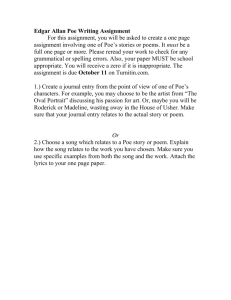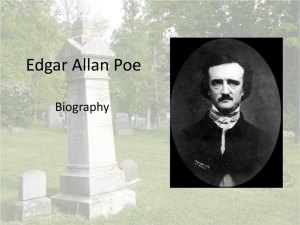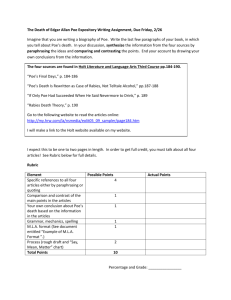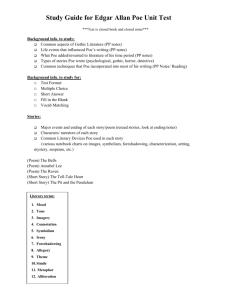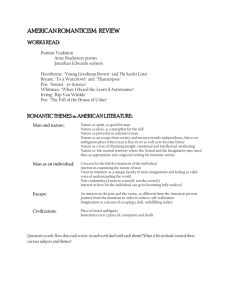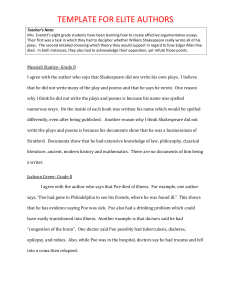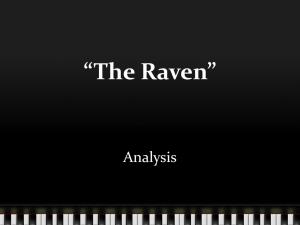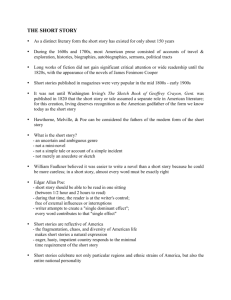Interactive Timeline - Knowing Poe
advertisement
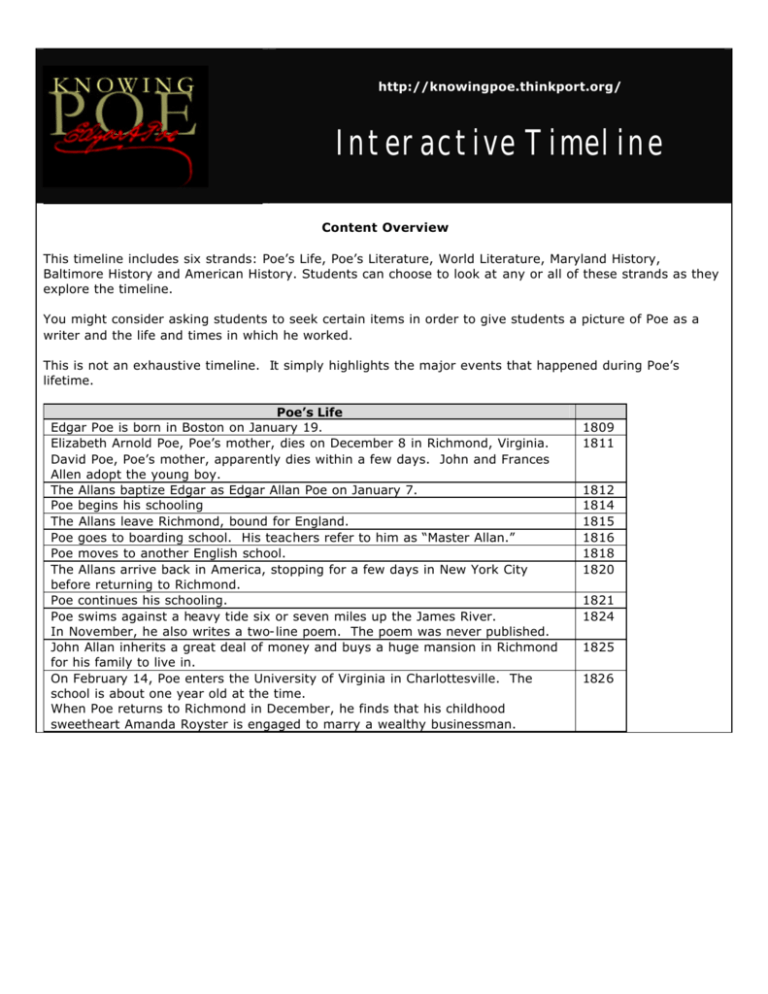
http://knowingpoe.thinkport.org/ Interactive Timeline Content Overview This timeline includes six strands: Poe’s Life, Poe’s Literature, World Literature, Maryland History, Baltimore History and American History. Students can choose to look at any or all of these strands as they explore the timeline. You might consider asking students to seek certain items in order to give students a picture of Poe as a writer and the life and times in which he worked. This is not an exhaustive timeline. It simply highlights the major events that happened during Poe’s lifetime. Poe’s Life Edgar Poe is born in Boston on January 19. Elizabeth Arnold Poe, Poe’s mother, dies on December 8 in Richmond, Virginia. David Poe, Poe’s mother, apparently dies within a few days. John and Frances Allen adopt the young boy. The Allans baptize Edgar as Edgar Allan Poe on January 7. Poe begins his schooling The Allans leave Richmond, bound for England. Poe goes to boarding school. His teachers refer to him as “Master Allan.” Poe moves to another English school. The Allans arrive back in America, stopping for a few days in New York City before returning to Richmond. Poe continues his schooling. Poe swims against a heavy tide six or seven miles up the James River. In November, he also writes a two-line poem. The poem was never published. John Allan inherits a great deal of money and buys a huge mansion in Richmond for his family to live in. On February 14, Poe enters the University of Virginia in Charlottesville. The school is about one year old at the time. When Poe returns to Richmond in December, he finds that his childhood sweetheart Amanda Royster is engaged to marry a wealthy businessman. 1809 1811 1812 1814 1815 1816 1818 1820 1821 1824 1825 1826 Sometime in the spring, Poe stays in Baltimore before joining the Army. He writes two untitled poems in personal albums of friends. The poems are now known as "To Margaret" and "To Octavia.” 1827 Edgar and John Allan fight over Poe’s college gambling debts. Poe leaves Richmond and goes to live with his family in Baltimore. On May 26, Poe enlists in the U.S. Army under the name Edgar A. Perry. Poe’s first book, Tamerlane and Other Poems, is published in Boston. Only 50 copies are sold. The rest are probably distributed for free. On October 20, Poe’s poem that today is known as “Dreams” is published in the Baltimore North American. The author is identified as “W. H. P,” or William Henry Poe, Edgar’s brother. On February 29, Frances Allan, Poe’s foster mother, dies. Poe gets leave from his commander, but arrives in Richmond on the evening of the day after her burial. At the time, he was stationed at Old Point Comfort, Virginia. 1829 Poe’s second book of poetry, Al Aaraaf, Tamerlane, And Minor Poems, is published in Baltimore. Poe is promoted to the rank of Sergeant Major of the Regiment of Artillery, the highest non-commissioned rank. Poe is released from his Army duties after paying for someone to take his place. He decides to seek an appointment to West Point. In May, Poe rents a room with his cousin at No. 28 Caroline Street (then No. 9). Soon afterwards, he writes an untitled poem in a friend’s album. Today we know the poem as “Alone.” Poe visits the Baltimore Assembly Rooms and Library frequently. In October, John Allan remarries. Poe leaves Baltimore and enters West Point. Poe, wishing to get out of his appointment to West Point, deliberately misses classes and breaks other rules. On March 6, he is dismissed. He moves back to Baltimore. 1830 1831 Poe's book Poems is published in New York. In July, Poe submits several stories to a contest sponsored by the Philadelphia Saturday Courier. He does not win first prize, but the magazine later publishes five of the stories he submitted, without identifying the author. On August 1, Poe’s older brother dies in Baltimore, probably of tuberculosis or cholera. In October, Poe wins the $50 first prize for a contest sponsored by the Baltimore Saturday Visitor. The story he submitted was “MS. Found in a Bottle.” John Allan dies, and leaves nothing to Poe. Poe applies for a teaching position at a school in Baltimore. He doesn’t get the job. Poe leaves Baltimore and moves to Richmond. Poe becomes the editor of Thomas W. White’s Southern Literary Messenger. On May 16, Poe marries his cousin Virginia Clemm in Richmond. Clemm is 13. 1833 1834 1835 1836 The Southern Literary Messenger announces that Poe is no longer editing the magazine. Poe and his family move to New York. Poe and his family move to Philadelphia. In May, Poe becomes the editor of the two-year old Gentleman’s Magazine Poe's Tales of the Grotesque and Arabesque (two volumes) is published in Philadelphia. 1837 1838 1839 1840 Poe's story “Journal of Julius Rodman” is mistaken for a true story when it is first published in January. Poe writes in the Saturday Evening Post, proposing a new monthly literary journal called Penn Magazine. Poe never was able to raise the funds for this venture. Philadelphia’s Saturday Evening Post announces that Poe will become the editor of Graham’s Magazine, starting in April. In April, the magazine features Poe’s “The Murders in the Rue Morgue,” the first modern detective story. During Charles Dickens’ tour of America, he and Poe meet. In May, Poe resigns as editor of Graham’s Magazine. Poe signs an agreement with Thomas Cottrell Clarke to proceed with another magazine, which Poe referred to as The Stylus. 1841 1842 1843 The first public biography of Poe appeared in the Philadelphia Saturday Courier. It was full of errors. Some think Poe provided the inaccurate materials himself. Poe tries to get a government job. He thought this kind of job would leave him time to write. Even though he has the support of the President’s son, Poe is not hired. In June, Poe’s short story, “The Gold-Bug” receives a $100 prize from Philadelphia’s Dollar Newspaper. The story brings him national attention. In November, Poe gives the first of a series of lectures on American poetry. The lecture is a great success. Poe and his family move to New York. 1844 Poe becomes part of the staff of the Evening Mirror. In January, Poe returns to Baltimore to give a lecture on Ame rican Poetry. The audience pays a 25-cent admission fee. Poe becomes the editor of The Broadway Journal. By October, he is the sole owner and editor of the magazine. 1845 In January, Poe’s poem, “The Raven” appears in the New York Evening Mirror. It is a sensational hit, earning Poe a great deal of fame. He was paid $15.00 by the Mirror. The Broadway Journal stops publishing because of financial problems. 1846 Poe moves his family to a cottage in Fordham, New York. In January, Poe’s wife Virginia dies from tuberculosis. 1847 Poe visits Baltimore. He meets with Robert D’Unger, who notes that Poe is very depressed about the death of his wife. Poe begins to court a New England widow and poet named Sarah Helen Whitman. In November, she agrees to marry him after he signs a pledge not to drink. When he goes back on his word in December, she breaks off the engagement. 1848 In the summer, Poe visits D’Unger in Baltimore. In June, Poe begins to tour the South to raise money to begin publishing The Stylus. 1849 In Richmond, Poe runs into his childhood sweetheart, Amanda Royster. Her husband has died. She accepts Poe’s proposal to marry him, even though it will mean she has to give up a great deal of the money her husband left her. On September 27, Poe sails for Baltimore, arriving the next day. On October 3, Poe is found unconscious on the street and taken to Cornelius Ryan's "4th Ward Polls," a tavern at Gunner's Hall, on East Lombard Street. On October 7, Poe dies in Baltimore. He is buried on the 8th or 9th in Westminster Burial Ground. Poe’s Literature "Poetry" (version "A", written probably in 1824) "O, Tempora, O, Mores!" (version "A," written probably in 1825) "To Margaret" (version "A," written probably between January and October of 1827) "To Octavia" (version "A," written about May 1, 1827) "[Untitled]" ["A Dream"] (version "A," printed about July of 1827) "Dreams" ["Song"] (version "A," printed about July of 1827) "Evening Star" (version "A," printed about July of 1827) "[The Happiest Day]" (version "A," printed about July of 1827) "Imitation" (version "A," printed about July of 1827) "The Lake" (version "A," printed about July of 1827) "[Stanzas" (version "A," printed about July of 1827) "Tamerlane" (version "A," printed about July of 1827) "To -- --" ["Song"] (version "A," printed about July of 1827) "Visit of the Dead" ["Spirits of the Dead"] (version "A," printed about July of 1827) "An Acrostic" (version "A," written probably in 1829) "Alone" (version "A," written probably in 1829) "[To Isaac Lea]" (version "A," written about May 27, 1829) "Elizabeth" (version "A," written probably in 1829) "Al Aaraaf" (version "A," excerpts only, printed May 18, 1829, Baltimore Gazette) "Al Aaraaf" (version "B," excerpts only, printed December 1829, Yankee and Boston Literary Gazette) "To -- --" (version "B," excerpts only, printed December 1829, Yankee and Boston Literary Gazette) "Al Aaraaf" (version "C," printed late in 1829) "Fairyland" (version "C," printed late in 1829) "Preface" ["Romance"] (version "A," printed late in 1829) "To -- --" (version "C," printed late in 1829) "[Lines on Joe Locke]" (version "A," written probably in 1829-1831, printed March 4, 1843, Philadelphia Saturday Museum) Pre1827 1827 1829 "Al Aaraaf" (version "E," printed in 1831) "The Doomed City" ["The City in the Sea"] (version "A," printed in 1831) "A Paean" (version "A," printed in 1831) "Fairy Land" (version "E," printed in 1831) "Introduction" ["Romance"] (version "C," printed in 1831) "Irene" (version "A," printed in 1831) "Israfel" (version "A," printed in 1831) "To Helen" (version "A," printed in 1831) "The Valley of Nis" ["The Valley of Unrest"] (version "A," printed in 1831) “The Bargain Lost” “A Decided Loss” “The Dream” (Philadelphia Saturday Evening Post, August 13, 1831) “The Duc De L’Omelette” “Metzengerstein” “A Tale of Jerusalem” 1831 "To Elizabeth" (written about 1833) "The Coliseum" (version "A," printed October 26, 1833) "Fanny" (version "A," printed May 18, 1833) "Serenade" (version "A," printed April 20, 1833) "The Assignation" “Epimanies” “Loss of Breath” “MS. Found in a Bottle” “Shadow” “Siope” "To Mary" ["To F----"] (version "A," printed July 1835) "Politian" (version "A," 1835) “Berenice” “Bob-Bon” “King Pest” “Lion-izing. A Tale” “Morella” “The Unparalleled Adventure of One Hans Pfall” "[May Queen Ode]" (version "A," written in April 1836) "Spiritual Song" (version "A," written in 1836) "Bridal Ballad" “Mystification” “How to Write a Blackwood Article” “Ligeia” “The Haunted Palace" (version "A," printed in April of 1839) "Sonnet -- Silence" (version "A," written December 25, 1839) “The Conversation of Eiron and Charmion” “The Devil in the Belfry” “The Fall of the House of Usher” “The Journal of Julius Rodman” (1839 – 1840) “The Man that was Used Up” “William Wilson” “The Business Man” “Lionizing” “Loss of Breath” “The Man in the Crowd” 1833 1835 1836 1837 1838 1839 1840 “The Colloquy of Monos And Una” “A Descent into the Maelstrom” “Eleonora” “The Island of the Fay” “The Murders in the Rue Morgue” “Never Bet the Devil Your Head” “Three Sundays in a Week” "The Conqueror Worm" (version "A," probably written late in 1842, printed in January of 1843) "Lenore" (version "A," probably written prior to December 25, 1842, printed in February of 1843, The Pioneer) “The Black Cat” “Landscape Garden” “The Masque of the Red Death” “The Mystery of Marie Roget” (1842-1843) “The Oval Portrait” “The Pit and the Pendulum” “The Tell-Tale Heart” “Diddling Considered as One of the Exact Sciences” “The Gold-Bug” "[Fragment of a Campaign Song]" (version "A," probably written in 1844) "The Raven" (version "A," written in late 1844, printed February 1845) "The Angel of the Odd" “The Balloon-Hoax” “The Literary Life of Thingum Bob, Esq.” “Mesmeric Revelation” “The Oblong Box” “The Premature Burial” “The Purloined Letter” “Some Words with a Mummy” “The Spectacles” “The System of Doctor Tarr and Professor Fether” “A Tale of the Ragged Mountain” “Thou Art the Man” “The Thousand-and-Second Tale of Scheherazade” "The Raven" (version "J," printed about September of 1845) “Facts of M. Valdemar’s Case” “The Imp of the Perverse” “The Power of Words” “The Sphinx” "Valentine's Eve" ["A Valentine"] (version "A," written on or before February 13 of 1846) “The Cask of Amontillado” The Domain of Arnheim” "Beloved Physician" (version "A," 1847) "Deep in Earth" "The Bells" (versions "A" and "B," written in early May of 1848) "The Bells" (version "C," written in 1848, printed December of 1849) “Landor’s Cottage” “Mellonta Tauta” “Morella” 1841 1842 1843 1844 1845 1846 1847 1848 "For Annie" (version "A," written March 23, 1849) "Annabel Lee" (version "A," written about May of 1849) "Eldorado" (version "A," printed April 21, 1849, Flag of Our Union) "Annabel Lee" (version "A," printed November of 1849) "The Bells" (version "G," printed November of 1849) “Hop-Frog” “Von Kemplen and His Discovery” “X-ing a Paragrab” World Literature Washington Irving’s History of New York is published. The Grimm Brothers’ Fairy Tales are published. Jane Austen’s Pride and Prejudice is published. Francis Scott Key writes “The Star-Spangled Banner.” It is originally titled “The Defense of Fort McHenry.” Congress purchases Thomas Jefferson’s 7000 volume library to replace the books burned in the Library of Congress when the British invaded Washington, D.C. Washington Irving's The Sketch Book of Geoffrey Crayon, Gent. is published serially in America. Samuel Taylor Coleridge's poem “Kubla Kahn” is published. Washington Irving’s “Rip Van Winkle” appears in the first installment of The Sketchbook, published in May. Cherokee chiefs approve the written alphabet for their language that had been developed by Sequoyah. The poem “A Visit from St. Nicholas” appears in the Troy, New York Sentinel. Twenty years later, Clement Moore claimed he wrote the poem. The first African American newspaper, Freedom’s Journal, is published in New York City. Noah Webster publishes American Dictionary of the English Language. Nathaniel Hawthorne’s earliest stories and sketches begin to appear in American publications. The abolitionist newspaper The Liberator begins publication. Hans Christian Anderson publishes his first book of fairy tales. The first monthly installment of Charles’ Dickens The Pickwick Papers is published in London. Nathaniel Hawthorne’s Twice-Told Tales is published. Charles Dickens’ Nicholas Nickleby and Oliver Twist are published. The first American edition of Alexis de Tocqueville’s Democracy in America is published. Richard Henry Dana’s book Two Years Before the Mast is published. Charles Dickens’ The Old Curiosity Shop is published. England’s satiric magazine Punch begins publication. 1849 1809 1812 1813 1814 1815 1816 1819 1821 1823 1827 1828 1830 1831 1835 1836 1837 1838 1840 1841 Ralph Waldo Emerson’s book Essays is published. It includes “Self-Reliance,” one of his most famous works. Charles Dickens’s A Christmas Carol sells 6,000 copies in its first printing. 1843 Henry David Thoreau begins living on Walden Pond. 1845 Frederick Douglass’ Narrative of the Life of Frederick Douglass, an American Slave is published. Eliza Acton’s first cookbook by a housewife for her peers, Modern Cookery for Private Families, is published. Herman Melville’s book Typee is published. 1846 Jane Eyre by Charlotte Bronte and Wuthering Heights by her sister Emily Bronte are published. Marx publishes his book The Communist Manifesto. Baltimore History The Washington Cotton Manufacturing Company is incorporated. The Mt. Washington facility is the first such company in the state. Alexander Brown and Sons, an investment firm, opens in Baltimore. 1847 The bombardment of Fort McHenry inspires Francis Scott Key to write the poem that became The Star-Spangled Banner. The Peale Museum (known as the Baltimore Museum and Gallery of Fine Arts) opens. It is the first public building serving as a museum to open in the United States. At Mt. Vernon Square, construction begins on the first architectural monument to honor George Washington. 1813 Samuel Kirk becomes the first silver makers in the United States. Rembrandt Peale demonstrates gas lighting at his museum, one of the first such displays in the U.S. Baltimore installs gaslights to illuminate the streets. It is the first American city to do this. Construction on the main section of the Basilica of the Assumption is complete. The Basilica is the first Roman Catholic cathedral in the U.S. The first Odd Fellows Lodge in the United States is founded in Fells Point. 1848 1809 1811 1814 1815 1816 1817 1818 1819 Isaac McKim begins milling flour using steam power, a first for the country. 1822 The Marquis de Lafayette revisits Baltimore. 1825 The Maryland Institute holds its first exhibition. Today the Institute is known as the Maryland Institute, College of Art. Thomas Kensett begins canning oysters for sale in retail markets. The Baltimore and Ohio Railroad Company is incorporated. It is the first U.S. railroad chartered to carry passengers and freight. On July 4, groundbreaking ceremonies are held for the construction of the Baltimore and Ohio Railroad. Charles Carroll, the last surviving signer of the Declaration of Independence, participates. Construction on the Shot Tower begins. The Oblate Sisters open a Baltimore school for young black children. The first Jewish congregation In Maryland is organized in Baltimore by John M. Dyer and twelve others. The congregation is called Nidhei Israel. A passenger railroad begins between Baltimore and Ellicott’s Mills, Maryland. It is one of the first public carrier railway in the country. The anti-Mason Party meets in Baltimore for the first presidential nominating convention in the US. The 116 delegates there select William Wirt of Maryland as their candidate. The first National Democratic Conference is held in Baltimore. The group renominates Andrew Jackson. A cholera epidemic hits Baltimore, killing over 800 people. In August, mobs of people demonstrate against the bank of Maryland and the people who run it 1826 1827 1828 1829 1830 1831 1832 1835 The Baltimore Sun begins publications. The Baltimore College of Dental Surgery opens, becoming the first such college in the country. Two important textile mills are opened up in the Jones Falls Valley. Jacob Davies is mayor of Baltimore. He serves until 1848. Eastern High School and Western High School are established as the first public high schools in the country for girls. Maryland History In Emmitsburg, Elizabeth Anne Seaton founds the Sisters of Charity, an order of nuns who worked in schools, hospitals, and orphanages. A constitutional amendment eliminates the need for office holders in the government to own property. The right to vote is taken away from free black people. Construction begins on the National Road, which eventually reaches from Cumberland to the Ohio River. Hagerstown is incorporated as a city. The British raid areas around the Chesapeake, including Havre de Grace. American forces best the British during the Battle of North Point. The National Road is completed, linking the Potomac and Ohio Rivers. Jim Pembroke, a slave in Maryland, escapes. In freedom, he chooses a new name, James W.C. Pennington. Pembroke/Pennington goes on to be a leader fighting to put an end to slavery. Boonsboro residents dedicate a monument to George Washington. The Chesapeake and Delaware Canal is opened. The Maryland State Colonization Society is founded. It later sets up a colony in Liberia for free black settlers from Maryland. Not many people took advantage of this. They thought it was an attempt to get rid of free black people, in part, so they could not help slaves to revolt. The state passes legislation to prohibit dredging for oysters. Tracks for the Baltimore and Ohio River reach Harper’s Ferry, West Virginia. Carroll County is formed, drawing its land from parts of Baltimore and Frederick Counties. Frederick Douglass escapes from slavery in Maryland, disguised as a sailor. For the first time, the people —not the legislature—elect the governor and State senators. Maryland passes a law stating that, if a free black person was found with any materials related to abolition, he or she can be placed in jail for 10-20 years. Samuel Morse’s telegraph connects Washington and Baltimore. His first message is “What hath God wrought?” The Naval Academy opens in Annapolis. Its first class includes 50 midshipmen, taught by seven professors. Harriett Tubman escapes from slavery in Southern Maryland American History The national census records that the population of the U.S. now stands at 7,239,881. On December 16, the largest known earthquake in American history (Richter scale 8.6. 8.4, and 8.8) reverses the flow of the Mississippi River. The quake is centered in New Madrid, Missouri 1837 1839 1844 1809 1810 1811 1813 1814 1818 1827 1829 1831 1832 1834 1837 1838 1841 1844 1845 1849 1810 1811 The U.S. declares war on Great Britain on June 12. The two nations had many disputes. British sailors had boarded American ships, and taken the sailors there into their own navies. The two still quarreled over boundaries on the Northwest Territory and the Canadian border. 1812 Louisiana becomes the 18th state. Jame s Madison is reelected to a second term as President. The White House, Capitol, and other buildings in Washington are burned by the British. 1814 On Christmas Eve, the U.S. and Britain sign the Treaty of Ghent, ending the War of 1812. In the Battle of New Orleans, Andrew Jackson and his rag-tag army defeat the British. Indiana becomes the 19th state. 1815 1816 The African Methodist Episcopal Church is founded in Philadelphia. James Monroe is elected President. Mississippi becomes the 20th state. 1817 Construction begins on the Erie Canal. Illinois becomes the 21s t state. 1818 Congress votes to limit the number of stripes on the flag to 13, one for each of the 13 original colonies. Alabama becomes the 22nd state. 1819 The Missouri Compromise is passed, balancing the number of free and slave states. Missouri is admitted as a place where slaves can be held. However, slavery will not be permitted in any other place north of Missouri’s southern border. Missouri becomes a state, making a total of 12 free states and 12 slave states. The Santa Fe Trail west opens. Denmark Vesey’s plans to lead a slave revolt are revealed, and he is convicted and hung, along with 35 others, in South Carolina. In December, President Monroe announces what becomes known as the Monroe Doctrine: the U.S. will not stand for any interference in American affairs by European powers John Quincy Adams is elected president. The Bureau of Indian Affairs is established. The Erie Canal, linking New York City and the Great Lakes, is completed. John Adams and Thomas Jefferson both die on July 4. Fort Leavenworth, Kansas, is established to protect the Santa Fe Trail. Andrew Jackson is elected to the Presidency of the United States. One of the first modern hotels, the Tremont, opens in Boston. Andrew Jackson’s offer to purchase Texas is turned down by Mexico. 1820 1821 1822 1823 1824 1825 1826 1827 1828 1829 The U.S. population stands at 12,866,020. 1830 Joseph Smith and others found the Church of Jesus Christ of Latter-day Saints. The U.S. Naval Observatory in Washington, D.C. becomes the official timekeeper for the country. The yard is standardized at 36 inches. Nat Turner leads a slave rebellion in Southampton County, Virginia. 1831 “My Country ‘Tis of Thee” is first sung in Boston. Andrew Jackson is reelected President. 1832 Public streetcar service begins in New York City. The fare is 12 cents. Oberlin College opens in Ohio. It is the first college to admit women and African Americans. Cyrus McCormick patents the horse-drawn reaper. General Santa Anna leads his troops in an attack of the Alamo in Texas. In December, Martin Van Buren is elected as the eighth U.S. President. Between 15,000 and 17,000 Cherokees are removed from tribal lands in Georgia and forced westward on what becomes known as the Trail of Tears. 1833 1834 1836 1838 Samuel Morse publicly demonstrates his telegraph system in Morristown, New Jersey. The Wilkes expedition to the South Pole sets sail from Virginia. Abner Doubleday “invents” baseball. The U.S. population reaches 17,069,453. 1839 1840 The Wilkes expedition sites land, claiming the discovery of Antarctica. President Van Buren signs an order mandating a ten-hour workday for workers. Factory workers at the time worked an average of more than 11 hours a day. Amistad mutineers are allowed to return to Africa through a Supreme Court decision. 1841 William Henry Harrison is inaugurated as President and dies a month later from pneumonia. John Tyler, his Vice President, becomes President. One of the earliest wagon trains to travel the Oregon trail arrives at Sacramento, California. The first adhesive postage stamps are made available by a private company Florida becomes the 27th state. The first uniform national election day takes place on November 4. 1842 1845 Texas becomes the 28th state. 1846 The Mexican-American War begins with a battle at Palo Alto, Texas Washington, D.C.’s Smithsonian Institute is founded. Iowa becomes the 29th state. Elias Howe invents the sewing machine. The first public demonstration of the use of ether in operations takes place at Massachusetts General Hospital. The Liberty Bell in Philadelphia tolled for the last time. Johnny Appleseed (John Chapman) dies in Indiana. 1847 The North Star, Frederick Douglass’ newspaper supporting the abolishment of slavery, begins publication in Rochester, New York. The Mexican-American War ends. 1848 Lucretia Mott and Elizabeth Cady Stanton convene the first Woman’s Rights Convention at Seneca Falls, New York. Gold is discovered in California at Sutter’s Mill, eventually starting the California Gold Rush. James Polk becomes the first President photographed in office. The Senate ratifies the Treaty of Guadaloupe Hidalgo, ending the MexicanAmerican War. Wisconsin becomes the 30th state in the United States. Zachary Taylor takes the oath of office, and becomes the nation’s 12th President. 1849


